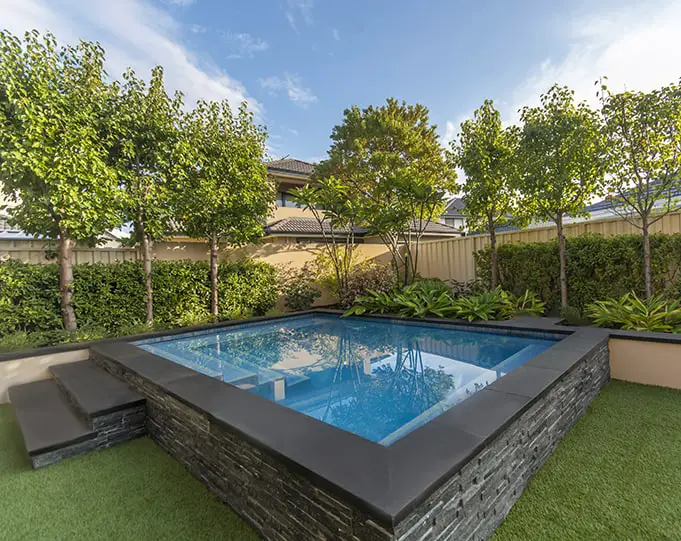
Swimming pool is something one would consider a luxury or something lavish, but on a hot summer day, when it is scorching hot outside, and most swimming pools are full and all you wanted to do is take a dip in the pool, relax and enjoy the day, that is when your own swimming pool at home can become one of your greatest investment. It gives you enjoyment and relaxation in the convenience of your own home, 24/7, 365 days a year, all year round.
What is a plunge pool? A Plunge pool is a small and shallow swimming pool, ranging from 4 meters to 7 meters in length, 2 meters to 3 meters wide but typically not deeper than 1.2 meters. It is much like a hot tub, an exercise pool or a swim spa without the engines and jets. It is a type of swimming pool that used for relaxation and allows you to cool off by plunging or dipping into the pool, hence the name, plunge pool. Basically, a plunge pool is a highly-compact pool where space is limited.
That is why Plunge pools have been becoming a popular must-have for relaxation at home. This is one of the fastest-growing in-demand types of pool mostly by Gen X and Baby Boomer generations but, with its continuous innovations and expanding trend, even the Millennial and Gen Z generations enjoy and consider this for their intricate home parties.
Further in the article, we will discuss and run through everything you need to know about the plunge pool before you decide if this is the right one for you.
What is a Plunge Pool?
Plunge pools are a great tool for those who need aquatic rehabilitation and therapy –a low impact exercise or therapy for the purpose of relaxation, fitness, physical rehabilitation, and other therapeutic benefits; or by those who needed or are advised by physicians to use or conduct exercises at the water.
According to researches, the popularity of plunge pools is mostly because of its convenient size. It is small but convenient and can fit a relatively small home and doesn’t take much space and time to maintain. Due to its size, which is comparatively smaller than a swimming pool, it requires less water and maintenance, which is a smart choice for economic and environmental sustainability.
What is a Plunge Pool Used For?
Practically, plunge pool is just a smaller version of swimming pools and both essentially work the same way. They are normally installed in-ground but can and are sometimes built above-ground. They have the same filters and pumps as the normal swimming pools. It may or may not be heated depending on your preference and need.
Plunge pool works and is primarily used for two activities. First, it is used for relaxation just like a pool spa where you and your family can enjoy dipping and lounging in the comfort of your own space. Secondly, it is used for aquatic exercise that includes eliminating joint pains, body pressures and reducing bodily stress and pains.
Sizing and Depth
To maximize the benefit of relaxation and therapy with the plunge pool it is important to consider the right sizing and depth for you.
An average plunge pool varies around 4 meters to 7 meters long, and 2 meters to 3 meters wide, but not deeper than 1.2 meters.
Essentially, any pool smaller than that of 6 meters is considered a plunge pool so it is up to you and your available location and space to customize the perfect plunge pool for your need.
Plunge Pool Cost?
One of the most common misconceptions with building a plunge pool is that since it is smaller than a regular swimming pool the cost must be a lot cheaper. Unfortunately, it is not. Usually, because it will be built on a conservative space, the design would take a bulk of the cost, plus the processing of the permits, the digging, and installation cost, it is likely only a little less than the cost of constructing an average size swimming pool. However, it requires fewer materials and decking needs.
Plunge Pool vs Above-Ground Inflatable Swimming Pool
So, why not just buy an above-ground inflatable swimming pool instead of constructing a fancy plunge pool?
While this is definitely an option, an above-ground inflatable swimming pool is not as sturdy and robust as a true plunge or exercise pool. It also only offers limited shapes – round, oval and sometimes square and rectangle for large pools while plunge pool since it can be designed as wanted would appeal more to those who prefer to dress up or design their free spaces or backyards.
While above-ground inflatable swimming pools will always have a market, the initial investment will most likely never be recovered and would only depreciate costs. On the other hand, a plunge pool will definitely increase the value of the property while you get to enjoy it.
Benefits of a Plunge Pool
Plunge pools have been becoming more and more popular for several reasons.
Small space requirements. Because the plunge pool is relatively smaller in size it easily fits into spaces where average size swimming pools cannot or would not fit. People often install a plunge pool alongside the patios and sometimes along the fence or wall of a home converting neglected location and areas into something new and useful.
Health Benefits. Latest pool trends for a healthy reason. The plunge pool is ideal for aquatic exercise, hydrotherapy, and rehabilitation.
Design Versatility. A plunge pool can be easily integrated into your landscape design. Adding a water feature in your pool is less hassle for this type of pool.
Easier to clean and maintain. Another benefit of a plunge pool is that it requires less maintenance and cleaning. It uses less water and fewer chemicals which is good for those who are into environmental sustainability plus it would mean fewer consumptions and more savings.
Lower installation fee. The area that is needed to be clear and dig is less, making the installation cost cheaper than a regular-sized swimming pool. The less the area of construction, the less the materials and manpower needed.
Temperature control. Plunge pools have a highly dependable heating or cooling systems to maintain the optimum temperature for a relaxing or therapeutic pool experience.
Drawbacks. Understandably just like other pool types, plunge pools have some drawbacks.
Size. Because of its small size, one of the biggest drawbacks of the plunge pool is that it can only fit a few people due to its limited size, unlike, the average swimming pool, the plunge pool can get crowded very easily.
Shallow water. Since kids love jumping on the swimming pool, this might pose a concern with a plunge pool and kids because there are no deep ends and kids might hit the hard bottom when they play.
Installing a plunge pool. The popularity of the plunge pool increases by time because it allows the homeowner to install a pool on limited spaces in their backyard.
Potentially, you can install your own plunge pool with your own design and feature.
Most plunge pools are prominently minimalist in style to allow the homeowner to maximize the limited space.
In terms of materials, concrete is one of the most popular choices since it can be constructed into different shapes and areas and can last up to 30 to 40 years. Other options are vinyl and fiberglass both capable of being installed in-ground or above.
For its running cost, the plunge pool requires less water and chemicals than regular pools but would still need decking, fencing, optional heating elements, pumps and filters like the traditional pool equipment.
Installing an in-ground plunge pool though smaller would require a bit of work with the digging and preparation while the above-ground plunge pool is a much faster alternative.
Having a small backyard doesn’t mean you can miss out on the joy and fun in owning a swimming pool. You can transform your small area into a beautiful and relaxing plunge swimming pool. Prepare your attractive pool design and start digging for a plunge swimming pool that will increase the aesthetic appeal and value of your property.

